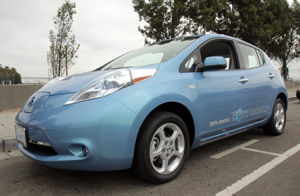
The California Air Resources Board has unanimously approved sweeping new rules designed to facilitate the transition from gasoline-powered to electric and hydrogen-powered cars. By 2025, automakers are now required to produce 1.4 million “zero-emission” vehicles for the California market, a number that would make clean cars 15 percent of all new car and truck sales.
The rules also require automakers, by 2025, to halve greenhouse gas emissions emanating from vehicle tailpipes, compared to current levels. The federal Environmental Protection Agency is considering similar emissions rules, as well as a new fuel economy standard of 54.5 mpg by 2025.
State regulators hope the new rules will lead to the widespread adoption of zero-emission vehicles, which they say is critical for meeting California’s goal of cutting greenhouse gas emissions 80% by 2050. That goal was established by executive order by Gov. Arnold Schwarzenneger, and goes beyond the cuts mandated by California's landmark global warming law, AB 32.
According to the board's calculations, zero-emission vehicles will have to make up nearly 100% of new car sales in 2040 and beyond to meet that goal. “Without [the transition from gasoline to clean cars], which may appear to be radical to people, you cannot lower CO2 emissions enough to stop the global climate change that’s occurring,” says Tom Cackette of the Air Resources Board.
The Air Resources Board estimates that the new rules will raise the average sticker price on 2025 model year cars by $1900. However, the board says, the savings in fuel costs over the life of the car will be three times that.
